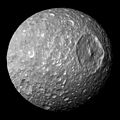Сурет:Mimas Cassini.jpg
Навигацияға өту
Іздеуге өту

Бұл алдын ала көрудің өлшемі: 600 × 600 пиксел. Басқа ажыратылымдықтар: 240 × 240 пиксел | 480 × 480 пиксел | 768 × 768 пиксел | 1024 × 1024 пиксел | 1800 × 1800 пиксел.
Түпнұсқа файл (1800 × 1800 пиксел, файл өлшемі: 943 КБ, MIME түрі: image/jpeg)
Файл тарихы
Файл сол кезде қалай көрінгенін көру үшін күн/уақыт дегенге басыңыз.
| Күн/Уақыт | Нобай | Өлшемдер | Қатысушы | Пікір | |
|---|---|---|---|---|---|
| қазіргі | 00:51, 2011 ж. қаңтардың 24 |  | 1800 × 1800 (943 КБ) | WolfmanSF | {{Information |Description ={{en|1=In this view captured by NASA's Cassini spacecraft on its closest-ever flyby of Saturn's moon Mimas, large Herschel Crater dominates Mimas, making the moon look like the Death Star in the movie "Star Wars." Herschel C |
| 08:36, 2010 ж. мамырдың 19 |  | 2000 × 2000 (864 КБ) | The High Fin Sperm Whale | {{Information |Description={{en|1=In this view captured by NASA's Cassini spacecraft on its closest-ever flyby of Saturn's moon Mimas, large Herschel Crater dominates Mimas, making the moon look like the Death Star in the movie "Star Wars." Herschel Crat |
Файл қолданылуы
Бұл файлды мына 3 бет қолданады:
Глобалды файл қолданылуы
Бұл файл келесі басқа уикилерде қолданылады:
- af.wikipedia.org жобасында қолданылуы
- am.wikipedia.org жобасында қолданылуы
- ar.wikipedia.org жобасында қолданылуы
- ary.wikipedia.org жобасында қолданылуы
- arz.wikipedia.org жобасында қолданылуы
- ast.wikipedia.org жобасында қолданылуы
- azb.wikipedia.org жобасында қолданылуы
- az.wikipedia.org жобасында қолданылуы
- ba.wikipedia.org жобасында қолданылуы
- be-tarask.wikipedia.org жобасында қолданылуы
- be.wikipedia.org жобасында қолданылуы
- bg.wikipedia.org жобасында қолданылуы
- bn.wikipedia.org жобасында қолданылуы
- bn.wikibooks.org жобасында қолданылуы
- br.wikipedia.org жобасында қолданылуы
- bs.wikipedia.org жобасында қолданылуы
- ca.wikipedia.org жобасында қолданылуы
- ckb.wikipedia.org жобасында қолданылуы
- crh.wikipedia.org жобасында қолданылуы
- cs.wikipedia.org жобасында қолданылуы
- cv.wikipedia.org жобасында қолданылуы
- cy.wikipedia.org жобасында қолданылуы
- da.wikipedia.org жобасында қолданылуы
Бұл файлдың глобалды қолданылуын көбірек көру.




